INSIDE ISSUE 17.42 | Oct. 19, 2018
NEWS: State tech school president spins wheels, raises awareness
BRIEFS: Nonprofit proffers insurance options, flooding, more
COMMENTARY, Brack: Gubernatorial debate was kind of boring
SPOTLIGHT: United Way Association of South Carolina
MY TURN, Buell: Spend tax money wisely on new voting machines
FEEDBACK: More context provided on undocumented workers
MYSTERY PHOTO: Creepy-looking place
S.C. ENCYCLOPEDIA: Drayton Hall
NEWS: State tech school president spins wheels, raises awareness and scholarship money
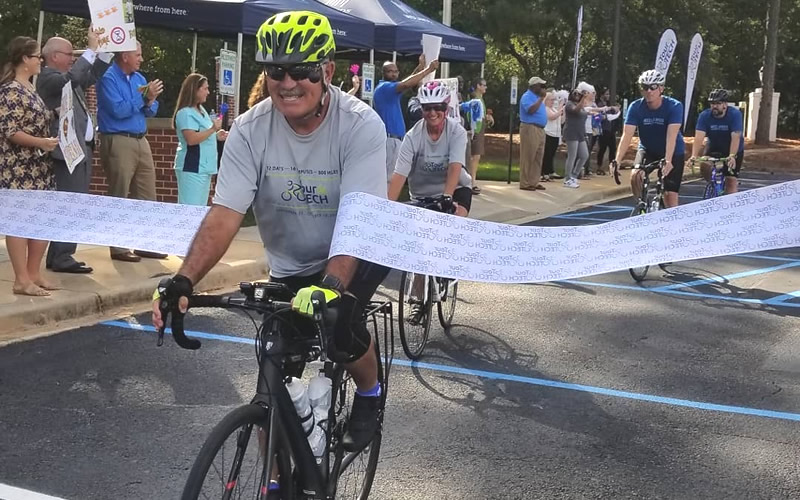
By Lindsay Street, Statehouse correspondent | If you want to find out what it’s like to cycle South Carolina during an unusually hot fall and hurricane season, all you have to do is ask Tim Hardee.
Hardee, president of the S.C. Technical College System, recently finished up an 800-mile slog last Friday, Oct. 12, at Horry-Georgetown Technical College in Conway after beginning at York Technical College in Rock Hill two weeks earlier. During that time, the state was hit with flooding weeks after Hurricane Florence’s landfall and then more rain came from Tropical Storm Michael. All the while, Hardee kept pedaling, his wife by his side
The adventure, called Tour de Tech after the world-known cycling race Tour de France, raised about $90,000 for student scholarships through corporate sponsorships. It also raised awareness about these higher education institutions, Hardee told Statehouse Report.
“It was well worth riding 800 miles on the bike to raise the scholarship money,” he said.
Hardee’s trip came as the schools are gaining popularity among students and employers in the state.
“(In the past, the schools were for) students unable to attend a four year institution. Now, it has become more of a priority choice for students who view it as, ‘For me, to enter the job market in a good-paying job quickly,’” Hardee said.
The value of technical education
Students can either earn a certificate or two-year degree and quickly enter the workforce, or they can go to tech schools for two years before transferring to a four-year college and save on tuition, he said.
S.C. Commission on Higher Education Executive Director Jeff Schilz told Statehouse Report that technical colleges can give students a good bang for their buck.
“More and more students are going to technical college for the community college side of things because they feel like they can get the general education at a reduced rate and it’s more convenient closer to home,” Schilz said.
The Commission on Higher Education has had a tour of its own across the state: asking higher education stakeholders to comment on their experiences as tuition rates rise around the state. Recently, it has floated freezing tuition hikes at four-year institutions. But Schilz said technical colleges in the state haven’t been the focus of student and parent ire.
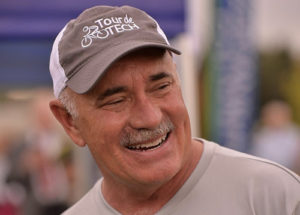
Hardee said technical colleges in the state have three things going for them: affordability, accessibility and relevance. He said the cost of tuition is about a third of what four-year institutions cost. Next, a technical college is located within 30 minutes of every S.C. resident (and 95 percent of technical college students are in-state). And finally, technical colleges provide geographically-relevant job training.
For example, if you’re near BMW in Greer, you can get training relevant for jobs that area, but if you’re near Myrtle Beach, you will receive a different kind of training more attuned to the tourism industry.
“They supply workers to a lot of companies that come to South Carolina,” Schliz said. He said that recently Volvo hired its 1,000th worker and that was attributed to Trident Technical College’s work in preparing its students through the state’s ReadySC program.
A listening tour
On the road, Hardee said he heard from businesses that relied on technical colleges for their workforce. He recalled that at Williamsburg Technical College in Kingstree, one employer said his workforce was made possible by the college.
“A lot of times we think of (technical colleges) in terms of BMW and Volvo, but this was a small industry that employed less than 50 people,” Hardee said. “He was able to benefit from the technical college.”
Unlike most public higher education institutions in the state, the technical college system is receiving more money than at the start of the great recession in 2008 — a pivotal moment for state-funded institutions. From a draft 2018 report by the S.C. Commission on Higher Education, a comparison of state dollars for universities shows:
- Clemson University received $86 million in state funds in 2008-09, and received little more than $80 million eight years later;
- The University of South Carolina’s main campus received $140 million million in 2008-09 and receive $127.6 million in 2016-17; but,
- Technical colleges in the state received $124 million in 2008-09 and received $128.4 million in 2016-17.
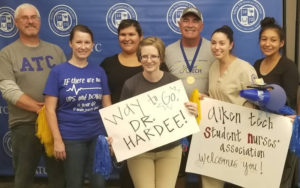
In other words, between 2008-09 and 2016-17, the state appropriated nearly 7 percent fewer dollars toward four-year higher education, but during that same time, technical colleges received 3.5 percent more funding.
“The legislature has continued to invest in the technical colleges, and I think the reason for that is that they view us as good investment,” Hardee said. “They recognize that, if the state is going to attract Volvo and Mercedes Benz vans and Michelin, then you have to have skilled workforce.”
Hardee said that while the state has continued to fund the technical colleges adequately in the state, the schools need more money allocated to keep training equipment up-to-date. In the 2018-19 budget, $11 million was allocated for such purchase, but that number gets eaten up quickly by 16 schools, he said.
Over the last five years, tuition has gone up 2 percent to 3 percent on average each year, Hardee said. That’s about on par with other higher education institutions in the state. At Clemson and University of South Carolina this year, students saw a rise in tuition at 1.75 percent and 2.9 percent respectively.
Hardee said that on his cycling tour, he spoke with students about the obstacles they face.
“Students were so appreciative of the financial support (offered through the school through the Tour de Tech fundraising),” Hardee said. He added that schools try to keep tuitions as low as possible, saying that sometimes $300 or $500 is the difference between a student being unable to enroll.
“Many times, they have to choose between paying the electric bill or paying their tuition,” Hardee said.
Hardee wouldn’t say if the Tour de Tech will become an annual tradition, but he wouldn’t rule out the possibility of a future spin around the state.
“I would consider it in the future, but right now I’m just recovering from these past few weeks,” he said.
- Have a comment? Send to: feedback@statehousereport.com
NEWS BRIEFS
BRIEFS: Nonprofit proffers insurance options, flooding, more
By Lindsay Street, Statehouse correspondent | South Carolina has its first-ever nonprofit health insurance agency following this week’s launch of InsureSC by the Palmetto Project.
![]() The employees at InsureSC act as agents, helping to steer customers toward insurance plans that best suit their needs and budget, according to InsureSC manager Shelli Quenga.
The employees at InsureSC act as agents, helping to steer customers toward insurance plans that best suit their needs and budget, according to InsureSC manager Shelli Quenga.
“We are a one-stop shop for anyone in South Carolina to figure out what their health options may be,” she told Statehouse Report Wednesday. She said because InsureSC is a nonprofit, there is no profit motive to sell other plans.
Quenga added that other for-profit insurance agents may steer clients away from Medicaid plans because there is no commission or revenue offered from such plans.
“You can come to us and we can figure out what your options are for coverage,” she said.
The nonprofit will make money off of other insurance plans and use that revenue to cover its expenses, Quenga said.
InsureSC marks a new chapter for Palmetto Project, which has ended its four-year contract with the federal government as an Affordable Care Act navigator citing uncertainty of funding. Since 2013, more than 200,000 South Carolinians have obtained private health coverage through the marketplace.
“This new approach allows us to continue to assist any South Carolinian in finding the most appropriate options for health care. It not only includes ACA policies, but Medicaid, Medicare, and non-ACA plans we’ve not been allowed to offer before,” Quenga said in a release.
In other recent South Carolina news:
Water, water everywhere. Four weeks after declining to comment for a Statehouse Report story seeking solutions for perennial and catastrophic flooding hitting the state, Gov. Henry McMaster has announced a flooding commission to study statewide solutions. Coastal Carolina University professor and S.C. National Guard commander Tom Mullikin Sr. of Camden is the commission chair. Its first meeting is slated for mid to late November. Read more here.
South loses 91 publications (with an asterisk for S.C.). The S.C. Press Association’s Facebook account shared a report this week that says the South has lost the most publications per any other region in the United States — but (and it was a big “but”) the association noted the report had a few inaccuracies for our state. For example, it lists five newspapers as closed but all are still publishing, some under a different or combined name. Also interesting to note in the report is that Allendale County is the only county in the state without a newspaper, although it is covered by neighboring Barnwell County publication, the Barnwell People-Sentinel, according to Press Association’s Jen Madden. But the report is accurate when it comes to a stark decline in circulation, she noted. She told Statehouse Report that a new directory of newspapers in the state is coming out in two weeks. Get your bookmarks ready, folks. (Or just subscribe to S.C. Clips and we’ll grab articles from those newspapers without you hunting them down!)
Winthrop president focuses on diversity. Winthrop University President Daniel F. Mahony addressed Winthrop this week on the school’s future plans and continued focus on diversity among students and staff. Mahony reported that minority students are excelling at the school and the school is continuing to get third-party endorsements for its successes. Read Mahony’s report here.
- Have a comment? Send to: feedback@statehousereport.com
BRACK: Gubernatorial debate was kind of boring
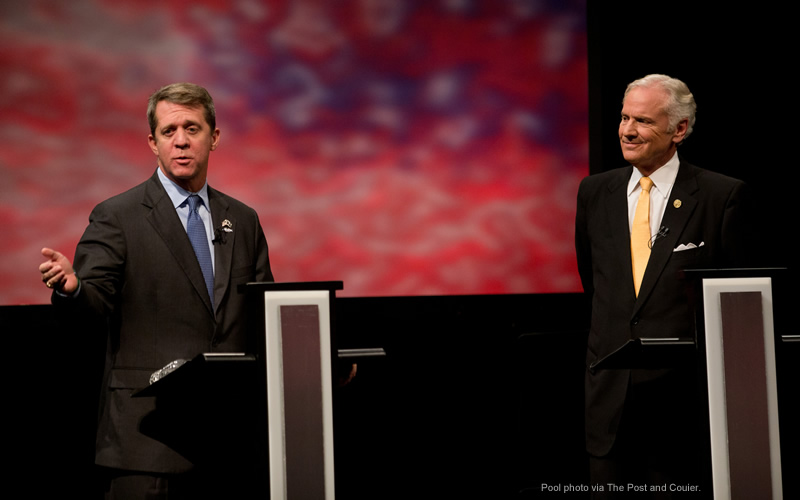
By Andy Brack, editor and publisher | What wasn’t said during the first of two gubernatorial debates between incumbent Gov. Henry McMaster and Democratic challenger James Smith was more telling than what was said.
 Smith got in a couple of good jabs, criticizing the governor for being less bold on everything from education to health care.
Smith got in a couple of good jabs, criticizing the governor for being less bold on everything from education to health care.
“We need a governor that cares more about our future than the next primary election,” Smith said.
McMaster, defending himself in a Southern drawl that was a lot thicker than it was 30 years ago, punched back with economics lessons that smacked of pure, GOP party playbook trickle-down economics. History and economics, he said, show reducing taxes and regulation increases prosperity. (The jury may still be out on that claim. Just look at how Kansas suffered after huge tax cuts in 2012.)
Nevertheless, the debate was, simply put, kind of boring. The status quo lived on. Viewers saw too many political platitudes thrown out as unseasoned, overcooked meat to sate an audience as tribalized and divided as the state and nation.
The two candidates danced and feinted, but there were no major punches landed. Their “debate” was mostly safe as if each were more worried about making a mistake than really giving voters good information about what they would actually do as governor.
So let’s look at what wasn’t said in the hour-long debate in a performance hall at Francis Marion University in Florence.
In a state with pockets of some of the highest, enduring poverty in the nation, there wasn’t much talk about how to lift up all South Carolinians from a basement they’ve been in too long. The candidates talked about too-high college tuition, but didn’t really give much insight into how to fix it.
Just weeks after storms that pummeled South Carolina, candidates were pretty vague about what specifically they would do to prepare for future storms. Smith called for more investment in infrastructure. McMaster touted his leadership in recent storms and called for the establishment of a new commission of experts to look into the problem. Just what we need. Another government commission.
A good example of the dance that was going on between both candidates was the seeming unwillingness to answer reporter Andy Shain’s questions about sales tax exemptions – the more than 80 tax breaks that have gone to special interests since the 1950s. Because of these breaks, the state does not receive more than $3 billion – yes, billion – in tax revenue that could go to schools, hospitals, jobs programs, colleges, law enforcement, prisons and more.
Smith, like McMaster, said he supported comprehensive tax reform, but didn’t really say which tax exemptions he wanted to reduce or cut. McMaster stuck to the trickle-down economics playbook by saying, “When you eliminate an exemption, you’re raising taxes. I want to have comprehensive tax reform, but I want them to go lower, not up.” Interestingly, earlier this month, McMaster told The Post and Courier something slightly different: “We must eliminate some exemptions to simplify our tax code,” according to an Oct. 14 story.
Something else that didn’t come up: President Donald Trump. McMaster, the first statewide elected official to endorse Trump, touted his close relationship with the president during the contentious Republican primary. But that relationship was almost invisible during the debate. And Smith, backed by vocal supporters in the audience, didn’t try to score any knockout punches by bringing up the president.
It was also surprising that there wasn’t much talk about two utilities that abandoned a nuclear power plant in Fairfield County, a debacle that cost $9 billion.
Best lines of the night:
Smith, in an opening statement on McMaster’s record of moving South Carolina forward: ““Henry, if this is winning, I would hate to see what losing looks like to you.”
McMaster on taxes: “The answer to economic growth and prosperity is lower taxes and lower taxes.”
Ronald Reagan: “There you go again.” (Actually, Smith invoked the line after being criticized by McMaster on taxes. McMaster interrupted that Smith was using a GOP quote from a 1980 debate between then President Jimmy Carter and GOP candidate Ronald Reagan. The wordplay gave the highly-charged audience an early laugh.)
- Have a comment? Send to: feedback@statehousereport.com.
SPOTLIGHT: United Way Association of South Carolina
 The public spiritedness of our underwriters allows us to bring Statehouse Report to you at no cost. This week, we shine a spotlight on the United Way Association of South Carolina. It is the common voice of the 29 independent, locally-government United Ways in the Palmetto State that work together to create long-lasting opportunities for everyone to have the good life. The organizations focus on education to help children and youths achieve their potential so they can get a stable job; income to promote financial stability and independence; and improving people’s health.
The public spiritedness of our underwriters allows us to bring Statehouse Report to you at no cost. This week, we shine a spotlight on the United Way Association of South Carolina. It is the common voice of the 29 independent, locally-government United Ways in the Palmetto State that work together to create long-lasting opportunities for everyone to have the good life. The organizations focus on education to help children and youths achieve their potential so they can get a stable job; income to promote financial stability and independence; and improving people’s health.
Advancing the common good is about helping one person at a time and about changing systems to help all of us. The associations believes we all win when a child succeeds in school, when families are financially stable, and when people are healthy. The organization’s goal is to create long-lasting changes by addressing the underlying causes of these problems. “Living United” means being a part of the change. It takes everyone in the community working together to create a brighter future. Give. Advocate. Volunteer. LIVE UNITED.
- More: http://www.uwasc.org
MY TURN, Buell: Spend tax money wisely on new voting machines
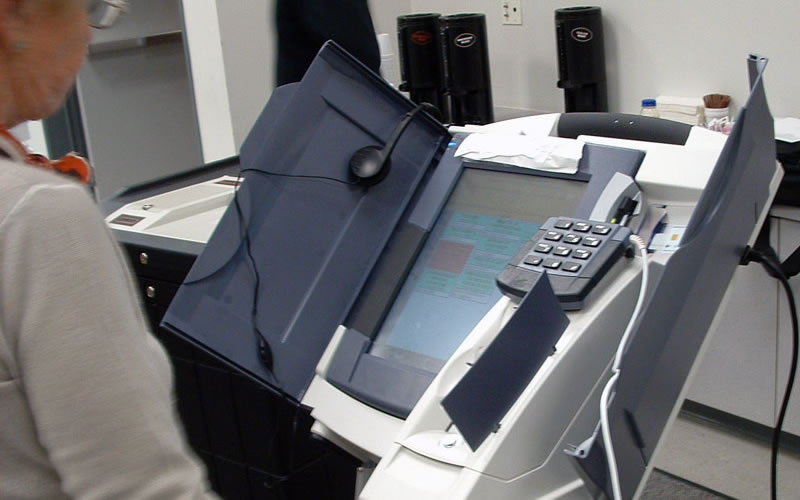
By Duncan Buell, special to Statehouse Report | Before South Carolina requests bids and spends tens of millions of dollars for new election equipment, we should look at what other states have done recently. South Carolina is not unique in having to replace outdated equipment.

One option is to replace the existing ES&S iVotronics voting computers more or less one for one with newer ES&S ExpressVote ballot marking device (BMD). Several bids and recent purchases put that cost at just under $5,000 for each voting computer. (These really are “computers” and not just “machines” so we will call them what they are.) South Carolina currently has about 13,000 iVotronics. At $5,000 each, that’s $65 million to replace. Buying in such a large quantity, we might do better, but even at $4,000 each, the price tag is $52 million.
This contrasts with changing from voting computers to hand-marked paper ballots, optical scanners for the paper, and one ballot-marking device per precinct to meet ADA (Americans with Disabilities Act) requirements for accessibility. For this option, we have several “comparables,” as would be said in the real-estate business.
Ohio went out for bids in 2017 for new election equipment. The bids from four major vendors came in between $8,500 to $11,000 per precinct, for a BMD (for accessibility) and an optical scanner. For South Carolina, with approximately 2,200 precincts, that comes to between $18.7 million and $24.2 million.
Michigan had a very similar estimate, of roughly $5,000 for a BMD and $5,000 for a scanner for each precinct, thus $10,000 per precinct, and $22 million for the 2,200 precincts in South Carolina.
A very different analysis was done in 2016 for the state of Iowa. There, where most voting is done on hand-marked paper, the estimate was that election equipment for the state cost about $3.73 per person (not per registered voter). The U.S. Census Bureau estimate for 2017 put the South Carolina population at just over 5 million people. At $3.73 per person for election equipment, that’s $18.65 million.
What is remarkable about these numbers is that very recent bids to three other states and an analysis from a totally different perspective all result in an estimated cost of $18.7 to $25 million for hand-marked paper and a scanner and a BMD in each precinct.
One negative of hand-marked paper is the ongoing cost of paper. We have a reliable estimate that for a large county in South Carolina, it would take 50 county-wide elections before the cost of paper made up the difference. And we must not overlook the ongoing cost of maintenance contracts for the BMDs or voting computers, which in large counties can be at least $100,000 per year.
A final argument regarding cost is the ability to add capability. Maricopa County, Arizona, (metropolitan Phoenix) votes on hand-marked paper. When additional space for voting is needed, they open up another 3×6 folding table and run to the office supply store for cardboard privacy screens. That’s a far cry from $5,000 each for an increase by only one in the number of voting stations in a precinct. Increasing from one scanner to two, at a cost of $5,000, doubles the scanning rate. Increasing from two to three for a very large precinct increases the scanning rate by 50 percent.
We do need to replace our current system, but as we plan to spend this much money, we should take guidance from other states with recent experience and make sure we spend the money wisely.
Duncan Buell, a member of the League of Women Voters of South Carolina, is NCR Professor of Computer Science and Engineering at the University of South Carolina.
- Have a comment? Send it to: feedback@statehousereport.com.
FEEDBACK
More context provided on undocumented workers
To the editor:
![]() Nice article. You wrote: “In 1986, President Ronald Reagan pushed through immigration reform that allowed amnesty for undocumented workers. In turn, families moved north to be with undocumented workers who decided to stay. Then came the September 11 attacks.”
Nice article. You wrote: “In 1986, President Ronald Reagan pushed through immigration reform that allowed amnesty for undocumented workers. In turn, families moved north to be with undocumented workers who decided to stay. Then came the September 11 attacks.”
Your history could have mentioned the giant sucking sound that was created by Reagan “Once in a Lifetime Amnesty” (which he sold of on in exchange for prohibition of employers hiring those without legal authorization to work). That ‘sucking sound’ was the noise created when all those migrants became newly-legalized immigrants then realized they could apply for 12-month-a-year/non-seasonal jobs with pay commensurate with their legal status (yea). ALL of those employers then without workers to do the job (at paid under the table rates and dangers) soon put out the word creating the next giant influx of illegal aliens.
Your history could have included the 1995-96 Seasonal Agricultural Worker Law that was nothing but a sham. The stated purpose was to ‘solve worker shortages for farmers for ever more’ by means of another amnesty. This one required only claims that the alien worked about three months over a period of three years (not correct but you get the idea). The fact that few records are kept by employers hiring illegals and fearing the new laws requiring employers to have employees complete I-9 certifications of authorization to be employed meant massive fraud.
Indian farmers in California filled out the verification forms by the gross. Nigerian cab drivers from Texas managed to become ‘lawfully admitted for permanent residence’ and every other type nationality that represented farmers and dairy types. The Immigration Service exams section did not interview the applicants, recognized the sham frauds, did not have resources to even do a preliminary inquiry, left notes in files to that effect and granted status.
The term ‘interior enforcement’ is/was a misnomer. Without any officials with time and authority and responsibility to remind “visitors” the have completed the purpose of their visit, their authorized time of visit had expired …. go home! It will be much the same all over. To say otherwise is to be like congressmen saying they want to hear what you think .. vote for me!
— Tim Houghtaling, San Mateo, Fla.
Send us a letter. We love hearing from our readers and encourage you to share your opinions. But you’ve got to provide us with contact information so we can verify your letters. Letters to the editor are published weekly. We reserve the right to edit for length and clarity. Comments are limited to 250 words or less. Please include your name and contact information.
- Send your letters or comments to: feedback@statehousereport.com
MYSTERY PHOTO: Creepy-looking place
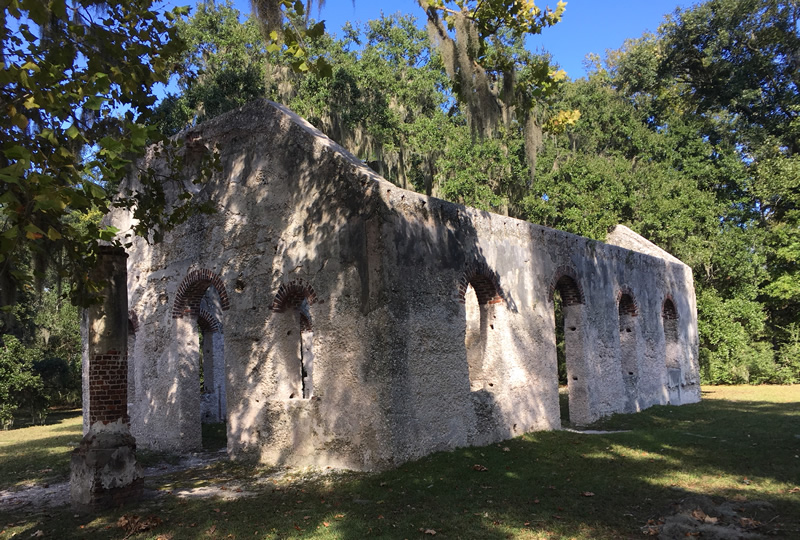
If we’re showing this photo as the weekly mystery, it must be close to Halloween. Where in South Carolina is this — and what is it? Send your guess to: feedback@statehousereport.com. And don’t forget to include your name and the town in which you live.
Our previous Mystery Photo
 Our Oct. 12 mystery proved to be a little harder than recent photos. It showed the “Fran Hanson Visitor Center at the S.C. Botanical Gardens on the wonderful Clemson University campus,” according to spotter Charlie Davis of Aiken, S.C. Others who correctly identified the photo were George Graf of Palmyra, Va., and Don Clark of Hartsville.
Our Oct. 12 mystery proved to be a little harder than recent photos. It showed the “Fran Hanson Visitor Center at the S.C. Botanical Gardens on the wonderful Clemson University campus,” according to spotter Charlie Davis of Aiken, S.C. Others who correctly identified the photo were George Graf of Palmyra, Va., and Don Clark of Hartsville.
Some more context via Graf: “According to upstateparent.com, “The gardens are at their most beautiful in the late spring and early summer, so now’s the time to plan an excursion.
If you’re just walking and taking in the scenery, it’ll take about an hour to do the main loop. You can easily double that time, however. The garden is pet-friendly.”
- Send us a mystery: If you have a photo that you believe will stump readers, send it along (but make sure to tell us what it is because it may stump us too!) Send to: feedback@statehousereport.com and mark it as a photo submission. Thanks.
S.C. ENCYCLOPEDIA
HISTORY: Drayton Hall
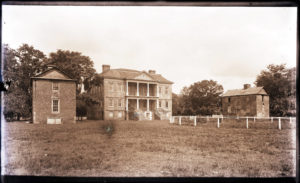
S.C. Encyclopedia | Established in 1738, Drayton Hall is a historic plantation located between the Ashley River and Ashley River Road, about nine miles from Charleston. At the time of its construction, its two-story, brick main house with raised basement was representative of current English Georgian architecture and was inspired by the designs of the Italian Renaissance architect Andrea Palladio. However, its recessed, two-story portico—the earliest of its kind in America—probably had no English precedent and was directly derived from Palladio’s The Four Books of Architecture, republished in 1715. Thus, Drayton Hall combined Old World design and eighteenth-century fashion with the tastes of the owner, the abilities of colonial craftspeople—black and white, free and enslaved—and the climate of the lowcountry to create a uniquely American architectural form.
John Drayton (ca. 1715–1779), born on the adjoining Magnolia Plantation, founded Drayton Hall at age twenty-three, and it remained in possession of the Drayton family for seven generations. As the seat of vast plantation holdings in the eighteenth and nineteenth centuries, Drayton Hall was the home of scores of African Americans who lived and worked there as slaves and later as free men, including the Bowens family, whose ancestors probably arrived as slaves from Barbados with the Draytons. In 1974 the National Trust for Historic Preservation, the state of South Carolina, and the Historic Charleston Foundation acquired Drayton Hall from the Drayton family. They chose to preserve the site “as is” rather than restore or reconstruct it to an earlier or specific time period, making its main house one of the oldest unrestored plantation houses in America that is open to the public.
— Excerpted from an entry by George McDaniel. This entry hasn’t been updated since 2006. To read more about this or 2,000 other entries about South Carolina, check out The South Carolina Encyclopedia, published in 2006 by USC Press. (Information used by permission.)
ABOUT STATEHOUSE REPORT
Statehouse Report, founded in 2001 as a weekly legislative forecast that informs readers about what is going to happen in South Carolina politics and policy, is provided to you at no charge every Friday.
- Editor and publisher: Andy Brack, 843.670.3996
- Statehouse correspondent: Lindsay Street
More
- Mailing address: Send inquiries by mail to: P.O. Box 22261, Charleston, SC 29407
- Subscriptions are free: Click to subscribe.
We hope you’ll keep receiving the great news and information from Statehouse Report, but if you need to unsubscribe, go to the bottom of the weekly email issue and follow the instructions.
© 2018, Statehouse Report. All rights reserved.



I haven’t followed the gubernatorial debates, but I can imagine your description of one as boring. What is it with this state? Why can’t we find any pols with fire in their bellies? I can understand why McMaster doesn’t need to get fired up, but why can’t the Dems find a firebrand? Trump doesn’t hesitate to yell from the podium; why can’t the Dems find a shouter of their own? I’m a Dem and I want my candidates to yell and get worked up when they’re in front of a crowd, not recite their talking points like they’re in church.